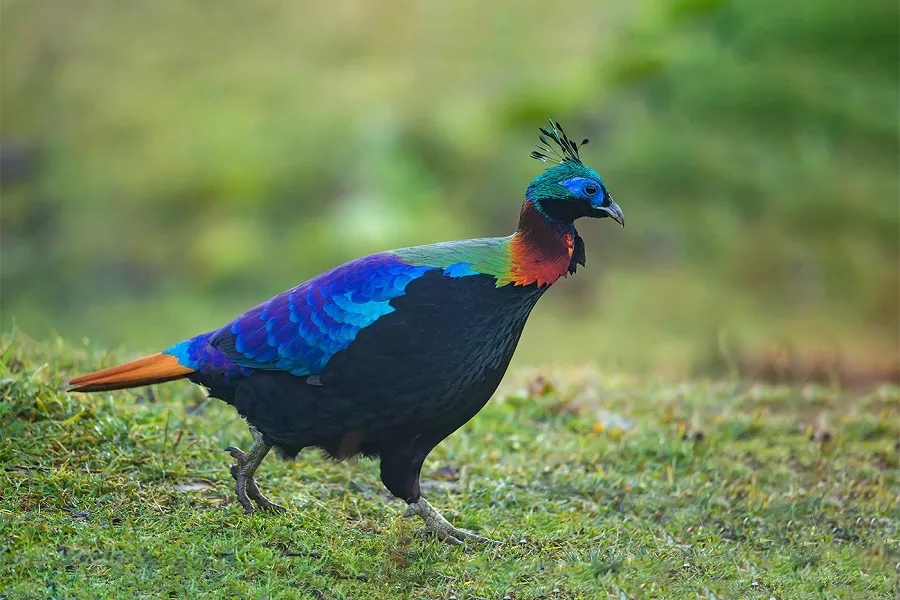The Himalayan Monal (Lophophorus impejanus), also known as the Impeyan Monal or simply the Monal, is a majestic bird that graces the mountainous regions of the Himalayas. This stunning avian creature holds special significance in the cultural and ecological realms. With its vibrant plumage, charismatic presence, and unique ecological adaptations, the Himalayan Monal has captured the fascination of naturalists, bird enthusiasts, and tourists alike. In this article, we will delve into the captivating world of the Himalayan Monal, exploring its physical characteristics, habitat, behavior, conservation status, and cultural importance.
Physical Characteristics
The Himalayan Monal boasts an impressive appearance, characterized by a kaleidoscope of colors. Males typically display a shimmering emerald green head, coppery feathers on the neck, a vivid blue back, and a prominent metallic green tail. The female counterpart, while less flamboyant, exhibits a graceful combination of browns and greys.
These birds are relatively large, with males measuring around 70-75 centimeters in length, including their long, broad tails. Their wingspans can reach up to 90 centimeters. Females are slightly smaller in size. Both sexes possess strong beaks and feet, which are well-suited for their mountainous habitat.
Habitat and Distribution
The Himalayan Monal thrives in the high-altitude regions of the Himalayas, ranging from western China through Nepal, Bhutan, and northern India. They inhabit coniferous and mixed forests, often found between 2,000 to 4,500 meters above sea level. These birds prefer areas with dense undergrowth and ample food sources, such as berries, seeds, insects, and small reptiles.
In their natural habitat, Himalayan Monals are often found in small groups or pairs. They are known for their elusive nature, preferring to retreat further into the forest when faced with human presence. During breeding season, however, males display an impressive courtship ritual, showcasing their vibrant plumage and emitting loud calls to attract females.
Behavior and Ecology
The Himalayan Monal is a diurnal species, meaning it is active during the day. These birds are well adapted to their mountainous environment, where they navigate through rocky slopes, shrubs, and trees with ease. Their strong wings allow them to fly swiftly, and they are capable of covering considerable distances.
During the breeding season, which typically occurs between April and August, male Monals engage in elaborate displays of courtship. The males perch on exposed rocks or branches, spreading their wings wide, erecting their feathers, and producing a range of vocalizations. These displays are not only intended to impress potential mates but also to establish territorial boundaries and ward off rival males.
Ecological Significance
The Himalayan Monal plays a crucial ecological role within its habitat. As an herbivorous bird, the Himalayan Monal diet consists primarily of plant matter, including seeds, fruits, buds, shoots, leaves, and flowers. In the process of foraging, the Monal contributes to seed dispersal, helping to maintain plant diversity and ecosystem balance. Furthermore, these birds are part of the intricate food chain, serving as prey for larger predators and scavengers.
Conservation Status
While the Himalayan Monal is not currently listed as an endangered species, its conservation status remains a cause for concern. Habitat loss, primarily due to deforestation, is a significant threat to these birds. The expansion of agriculture, logging, and infrastructure development in the Himalayan region has led to the degradation and fragmentation of their habitat.
Additionally, the illegal wildlife trade poses a significant risk to the Himalayan Monal. Their striking beauty and cultural significance have made them desirable targets for poachers. Conservation efforts are crucial to ensure the long-term survival of this magnificent bird.
Various organizations and governments in the region are working towards protecting the Himalayan Monal and its habitat. Initiatives include creating protected areas, raising awareness, implementing sustainable land-use practices, and combating illegal wildlife trafficking. Community engagement and education play vital roles in fostering a sense of responsibility and stewardship towards these remarkable creatures.
Cultural Importance
The Himalayan Monal holds immense cultural significance, particularly in Nepal. It is the national bird of Nepal and features prominently in the country’s folklore, art, and religious ceremonies. The bird symbolizes beauty, grace, and harmony, resonating with the ethos of the Nepalese people.
In festivals such as Dashain and Tihar, images or representations of the Himalayan Monal are used as decorations and offerings. Its feathers are considered auspicious and are often used in traditional costumes and ornaments. The bird’s presence in local mythology and legends further reinforces its cultural importance.
Conclusion
The Himalayan Monal stands as a testament to the awe-inspiring diversity of our natural world. Its breathtaking beauty, ecological adaptations, and cultural significance make it an iconic species that deserves our attention and protection. By understanding and appreciating the wonders of the Himalayan Monal, we can contribute to its conservation and ensure its continued existence for generations to come.


 Facebook
Facebook  Instagram
Instagram  Youtube
Youtube 